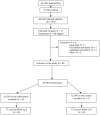Faster return to work after psychiatric consultation for sicklisted employees with common mental disorders compared to care as usual. A randomized clinical trial
- PMID: 20856601
- PMCID: PMC2938286
- DOI: 10.2147/ndt.s11832
Faster return to work after psychiatric consultation for sicklisted employees with common mental disorders compared to care as usual. A randomized clinical trial
Abstract
Introduction: Return to work (RTW) of employees on sick leave for common mental disorders may require a multidisciplinary approach. This article aims to assess time to RTW after a psychiatric consultation providing treatment advice to the occupational physician (OP) for employees on sick leave for common mental disorders in the occupational health (OH) setting, compared to care as usual (CAU).
Methods: Cluster randomized clinical trial evaluating patients of 12 OPs receiving consultation by a psychiatrist, compared to CAU delivered by 12 OPs in the control group. 60 patients suffering from common mental disorders and ≥ six weeks sicklisted were included. Follow up three and six months after inclusion. Primary outcome measure was time to RTW. Intention- to-treat multilevel analysis and a survival analysis were performed to evaluate time to RTW in both groups.
Results: In CAU, referral was the main intervention. Both groups improved in terms of symptom severity and quality of life, but time to RTW was significantly shorter in the psychiatric consultation group. At three months follow up, 58% of the psychiatric consultation group had full RTW versus 44% of the control group, a significant finding (P = 0.0093). Survival analysis showed 68 days earlier RTW after intervention in the psychiatric consultation group (P = 0.078) compared to CAU.
Conclusion: Psychiatric consultation for employees on sick leave in the OH setting improves time to RTW in patients with common mental disorders as compared to CAU. In further research, focus should be on early intervention in patients with common mental disorders on short sick leave duration. Psychiatric consultation might be particularly promising for improvement of RTW in those patients.
Trial registration number: ISRCTN: 86722376.
Keywords: RCT; anxiety disorder; major depressive disorder; mental disorders; psychiatric consultation; sickness absence; somatoform disorder.
Figures
References
-
- Bilsker D, Wiseman S, Gilbert M. Managing depression-related occupational disability: a pragmatic approach. Can J Psychiatry. 2006;51:76–83. - PubMed
-
- Bowling A. What things are important in people’s lives? A survey of the public’s judgements to inform scales of health related quality of life. Soc Sci Med. 1995;41:1447–1462. - PubMed
-
- Nederlands Instituut van Psychologen (NIP), Landelijke Vereniging van Eerstelijnspsychologen (LVE) Werk en Psychische Klachten. Richtlijn Voor Psychologen. Amsterdam, The Netherlands: NIP/LVE; 2005.
-
- Bijl RV, Ravelli A, van Zessen G. Prevalence of psychiatric disorder in the general population: results of The Netherlands Mental Health Survey and Incidence Study (NEMESIS) Soc Psychiatry Psychiatr Epidemiol. 1998;33:587–595. - PubMed
LinkOut - more resources
Full Text Sources
Miscellaneous



